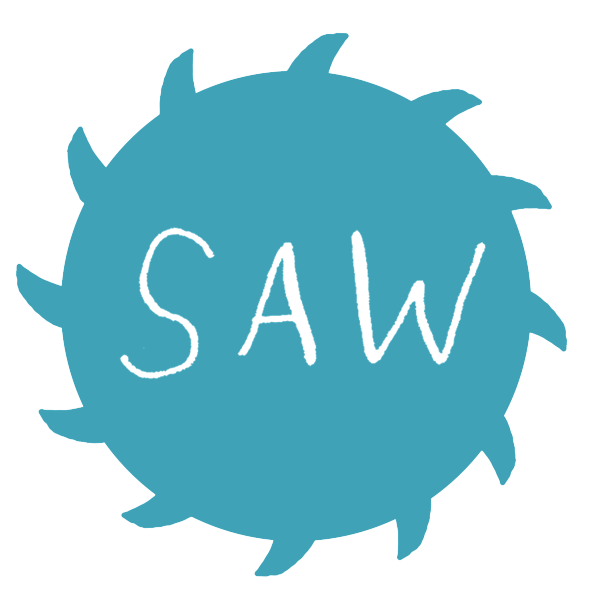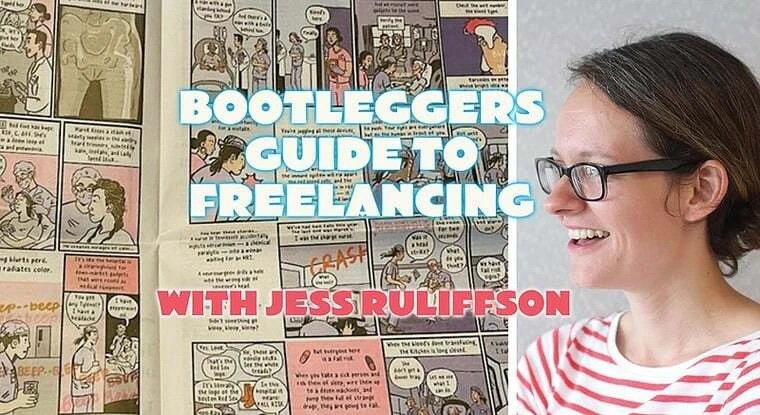The Terrible Anvil - Feeling Bad After Pitching Your Graphic Novel - Episode 7
I Pitched a Book and Now I Feel Bad
Hi, Friends!
For those of you just joining in, and anyone listening, we're hoping to record about twenty episodes of The Terrible Anvil, from now til May 30th! These recordings are archived on our SAW YouTube channel, and you can get the weekly episodes wherever you stream podcasts. Leave us a comment here or on YouTube if you have a question for us! (Note: use that handy "@" symbol to tag me, Tom, or SAW so we're sure to see your comments.)
This episode, we continued the topic of pitching, now focusing on The Art of the Book Pitch! And also: feeling bad about book deals!
Title card for Jess’s class, “Bootleggers Guide to Freelancing with Jess Ruliffson.” Jess’s smiling profile is on the right, a newspaper open to a spread of comic strips is on the left.
This might also be a good time to mention I'm hosting a four week course on freelancing for cartoonists--if you're a newbie or an old hat at this stuff, we can learn a lot together! Visit our online courses to see if there's something coming up this spring you'd like to dig into.
Our outline for the call!
1) Book pitching, with two subtopics--
- Agents and (big to biggish) Publishers
- Small Presses and Self-Publishing
2) I Got a Book Deal and Now I Feel Terrible
(Tom mentioned a few weeks ago: “Talking with Janna Morishima right now and talking about artists who feel lousy during their book contract! she really wants us to talk about that!”)
3) Making Money AND Art (in a capitalist society, or other societal models)
I dunno if we hit all of the above, but we did talk about big feelings on publishing books and why we have them, and also why we make art. Is a Big Five deal utilitarian? Tom says maybe no that's not why we're HERE (against but inside capitalism) - it's tricky!
We also quoted some from Keep Going by Austin Kleon and J.F. Martel's Reclaiming Art in the Age of Artifice:
A screenshot of two quotes. Abbreviated from Martel: “What’s the standard reaction these days? ‘You could sell this on Etsy!’ After the birthday girl opens her gifts, your baker friend serves her cake. Everyone is moaning in delight. What do they all say? ‘You could start a bakery!’ We’re now trained to heap praise on our loved ones by using market terminology. The minute anybody shows any talent for anything, we suggest they turn it into a profession. This is our best compliment: telling somebody they’re so good at what they love to do they could make money at it. We used to have hobbies; now we have ‘side hustles….’”
And from Kleon: “How to stay alive: (1) Find something that keeps you spiritually alive, (2) Turn it into a job that literally keeps you alive, (3) Oops! Go back to step one”
We had some good comments over in the Comics FLOW + PUBLISH group on these topics, including:
Deanna Feinstein wondered,
"Social media and technology has rapidly changed society in the past decade. How has social media effected the publishing industry and pitching a book?"
Cara Gormally posted their awesome comic on this very subject!
Screenshot from Cara Gormally’s Substack. “I want to talk about the feelings of writing a book because it’s such a process.” A color wheel broken up into dozens and dozens of emotions, increasing in specificity from the center, next to a cartoon of Cara saying, “Have you ever seen the feelings wheel? Making a book* involves this entire rainbow.”
And that was all before we even pressed the 'record' button today! Here's a few more gems from the call:
Jim Hamilton asked, "Who are the big five publishers?" and I missed it. Just Googling now it looks like:
Penguin Random House
Hachette
HarperCollins
Macmillan
Simon & Schuster
Alison Kent mentioned: Cannot recommend ENOUGH Filth & Grammar by Shelly Bond, thanks to Donna Druchunas for pointing us to this. How to make comics from the point of view of an editor.
Book cover of Filth & Grammar: The Comic Book Editor’s (Secret) Handbook by Shelly Bond, with Imogen Mangle and Laura Hole. An illustration of an editor sitting at their desk, designing this book cover and talking angrily on the phone, red pen in hand.
We talked about both creators and publishers creating realistic expectations and boundaries--if a publisher doesn't give you a deadline, don't wait for them to hand you one! You might need to build you own. I thought having a looming book deal would give me the accountability to stay on track, and while it sort of did, it mostly stressed me out. I'm so grateful I was able to publish a beautiful book, but it was a lot more difficult than I thought it would be (see those pesky "feelings" Cara Gormally mentioned above.)
Tom Hart talked about his second-book slump where he tasked himself with outlining a sequel to his beautiful graphic memoir, Rosalie Lightning. At the end of his twenty-some page outline, Tom didn't want to make that book! It ended up becoming the seed for his book The Art of the Graphic Memoir.
Tom said a paraphrase of a great quote, whose origins are unknown to me:
"How to get a book deal? First get famous!"
I chimed in: "If I’m not going to make any money I might as well make comics!"
Later on the call Tom Hart and I tried to speak to this great idea from Adrean Clark :
"I wonder if it's possible to talk about transforming our work -- not everything has to be something to "go big or go home" on. An idea can be a self-published zine, can be a comic feature in a newspaper, and so on. Thinking about the full range of pitches, whether to pitch to ourselves or to others. Does that make sense?"
Tom Hart read this quote I sent him from an article, via J.F. Martel:
Screenshot of another Martel quote: If we could see without the veil of utilitarianism, of habit, of reflex—if we could just see the world as it is—perhaps it would all strike us as being sublimely beautiful. Maybe art is just a matter of framing little bits of the world and polishing them a bit so that the beauty that was inherently there can be available to others.”
I also added: "spend time with your own work for a long time before launching it from the (marketing) cannon!"
We remembered the awesome Pro Call with Laura Gao, you can see the recording over here! Their process and the timeline for their book deal (Messy Roots) was super-duper fast and a ton of work all at once after their comic went viral. (Thanks Jim for the Pro Call link!!!)
Tom Hart mentioned the art critic Heidi MacDonald's podcast interview with comics creator Box Brown. Box said: "I feel stupid for following my dreams!" Re: capitalism can kinda make things feel cruddy.
Tom noted that "There are a lot of reasons to feel bad while making art. Most of those are expectations of results, expectations, rewards"
He noted the value of self publishing and Jim added: "I agree with Tom! I just ordered 100 of my books from Lulu. And that was after a couple of proofing cycles."
I asked Tom, “Is art-making perhaps a form of mental illness?” and he said, "Art is not a mental illness but a sane response to an insane world."
Leonie Sharrock asked:
Question re 'form' … what happens when you want to go hybrid? how do we pitch hybrid works?
Tom Hart said:
Leonie, those are more difficult but slowly people catch on… 🙂
Tune in for Episode 8 of The Terrible Anvil: Monetizing Every Moment of Waking Existence on Instagram (What Could Go Wrong?)
WANT TO MAKE AND READ MORE COMICS?
Do you have a story inside you that’s just itching to come out, but want some guidance to help push it out?
Learn more about intensive comics learning with teachers at SAW by checking out SAW’s Year-Long Intensive Program and our Six-Month Graphic Novel Intensive.
Be sure to also check out our Online Courses, some courses are offered year-round and are always enrolling while others are limited in space and come around only once a year!
Our Graphic Memoir Intensive runs year round and is always enrolling. It includes access to a vibrant working community, twice-monthly live online check-ins, weekly prompts, and access to SAW’s Monthly Pro Calls!
Our Comics Flow Group, or SAW FLOW MEMBERSHIP, is also year-round and always enrolling and is SAW's MOST AFFORDABLE course option with access to Monthly Pro-Calls!
And, of course, come see what we’re all up to on SAW's Mighty Network anytime!





